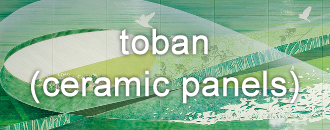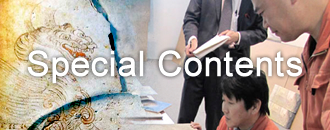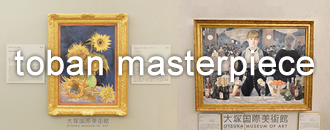Home > The Making of Toban Masterpieces
The Making of Toban Masterpieces
"Toban masterpieces" displayed at Otsuka Museum of Art.
"Toban masterpieces" created by Otsuka Ohmi Ceramices Co., Ltd.
The "toban masterpieces"at Otsuka Museum of Art are reproductions of world's masterpieces on large ceramic boards. Not only with the size and coloration, but also with the actua surface texture and brush strokes which are faithfully reproduced from the original artwork. Such reproduction quality is highly appraised by the original artwork owners. In addition, the toban masterpieces play an important role to archive valuable works of art including national cultural assets thanks to its semi-permanent durability . The Otsuka Museum of Art exhibits more than 1,000 toban masterpieces produced by Otsuka Ohmi Ceramics. From ancient murals to modern paintings, owned by more than 190 museums in 25 countries worldwide, only Otsuka Museum of Art offers the opportunity to see such a variety of western masterpieces in one place.

A perfect reproduction almost mistaken as the original! A long perservering path from start of design to the end of display installation of toban masterpieces.
STEP 1
Tenacious efforts to obtain consents from the original copyright holder
The first step in reproducing a toban masterpiece starts with obtaining a consent from the original copyright holder or owner. The staff of exhibition selection committee and Otsuka Ohmi Ceramics visited each copyright holder/owner to obtain consent to reproduce the selected artwork as a toban masterpiece.
For the complete reproduction of the Sistine Hall, the Cardinal of Japan wrote a handwritten letter supporting this reproduction to receive a consent from the Secretary of State, Vatican City.

STEP 2
Grasp every single detail of the original by on-site inspection
Once a consent is obtained, checking the original artwork as well as onsite inspection is conducted as much as possible. In most cases, information on the artwork is not recorded in books/documents; therefore, numerous photographs were taken to check the entire artwork from a whole view to detailed angles and scratches, the unevenness of the surface, damaged areas. The compiled photo data become the reference to reproduce the orginal with perfection. Further, inspection included the affect of light rays as well as from interviews with local experts Additional photographing was necessary to reproduce toban masterpieces with perfection in some cases.

STEP 3
Creating color transfer sheets
To transfer the colors on to a ceramic panel, a special transfer paper is applied after separating the colors from the original photograph.
First, the image is analyzed separating the colors into four colors of red, blue, yellow, and black. Overlaying a special ceramic paint on to each separated color in rotation, a special color transfer sheet is then created.The transfer sheet is placed over a bare ceramic panel for firing and the four colors of paint blend together recreating the original art coloration.

STEP 4
The Final touch up by our skilled artisans

STEP 5
Inspection of the finished reproduction
Once the toban artwork completes firing, the finished reproduction will be inspected by associated supervisors and proprietary holders of the original art. On right is a photograph shows Director of Antiquities of Padua inspecting the reproduction of the Scrovegni Chapel.

Final Step
Exhibition at the Otsuka Museum of Art
The final step to install the completed artwork in the museum is also carefully calculated. All artworks are basically displayed at an appropriate height and position to touch and experience the actual surface texture of the reproduction. A major attribute unlike other museums is the proximity with the artwork to appreciate every detail of the original. Furthermore, since the reproduction is the actual size of the original, you can appreciate the powerful sensation as in the original museum which is a totally different impression from books or on the internet. There may be new unaware discoveries by appreciating the reproduced toban masterpieces. click here for the Otsuka Museum of Art website.



